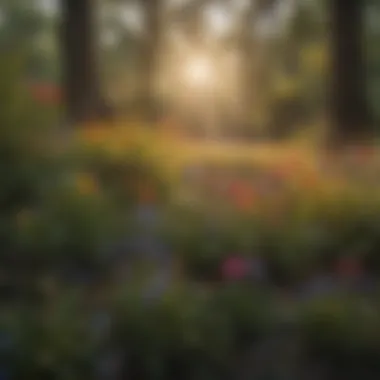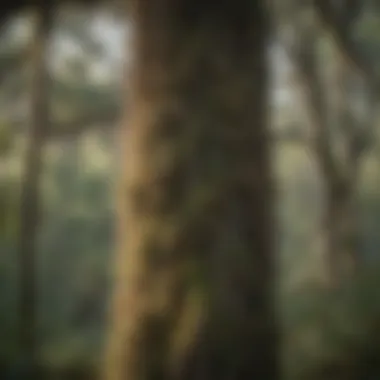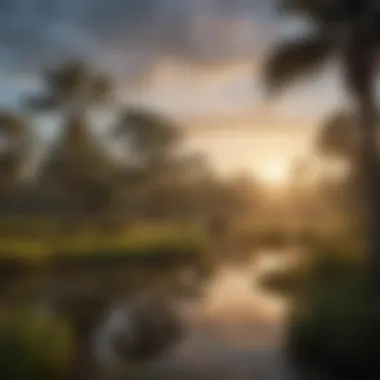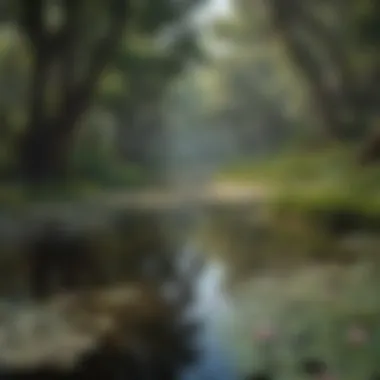Exploring Louisiana's Unique Flora and Fauna


Intro
Louisiana's landscape is a complex tapestry of diverse plant species and rich floral displays. This state, with its unique climate and geography, has cultivated a distinctive array of flora that contributes significantly to its ecological and cultural heritage. Exploring the state’s flora is essential for understanding not only the biodiversity it offers but also the ecological roles these plants play within their respective ecosystems.
As we delve deeper into this topic, we will discuss the ecological significance of these species. The impact of climate on plant growth cannot be underestimated. Additionally, we will examine how geography shapes the distribution of plants across Louisiana's varied landscape. Furthermore, the article will explore conservation efforts aimed at preserving these vital resources, emphasizing their importance to local ecosystems and to global biodiversity.
By the end of this article, readers will gain a comprehensive understanding of Louisiana’s plants and flowers, their unique characteristics, and the pressing need for continued conservation efforts in the face of environmental changes.
Overview of Forestry Practices
Forestry practices are integral to maintaining healthy ecosystems in Louisiana. It is essential to grasp the definition and importance of forestry in ecosystem management to appreciate its role in conserving plant diversity.
Definition of Forestry
Forestry encompasses the management of forests, woodlands, and related resources. This practice aims to balance ecological health with economic viability. Sustainable forestry practices can help maintain and enhance biodiversity while contributing to local economies.
Importance of Forestry in Ecosystem Management
Forestry is crucial for several reasons:
- It helps maintain habitat for various species.
- Forests act as carbon sinks, reducing atmospheric carbon levels.
- They regulate water cycles, which is vital for surrounding ecosystems.
- Proper management prevents soil erosion and degradation.
By recognizing the importance of forestry, stakeholders can work towards practices that benefit both the environment and local communities.
Sustainable Forest Management
The concept of sustainability in forestry speaks to the need for practices that will meet the current needs without compromising future generations. It becomes imperative to understand the principles and techniques involved.
Principles of Sustainable Practices
Sustainable forest management encompasses several core principles:
- Ecosystem Approach: Focus on maintaining the health of forest ecosystems.
- Stakeholder Involvement: Engage local communities in decision-making processes.
- Long-Term Planning: Consider the long-term implications of harvest methods and land use.
Techiques in Sustainable Management
Various techniques are employed in sustainable forest management:
- Selective logging minimizes environmental impacts by removing only certain trees.
- Replanting native species enhances biodiversity after logging.
- Monitoring ecosystems helps assess the health of the forest and adjust practices as necessary.
These strategies ensure that forestry contributes positively to the ecology of Louisiana.
Woodland Stewardship Strategies
Woodland stewardship involves responsible management of forested areas to maintain their ecological integrity. Understanding its importance can inspire landowners to adopt suitable practices.
Importance of Woodland Stewardship
Woodland stewardship plays a critical role in preserving biodiversity, enhancing habitat quality, and supporting the local economy. Healthy woodlands not only provide resources but also offer recreational opportunities and improve air quality.
Best Practices for Landowners
Landowners can implement several best practices for effective woodland stewardship:
- Conduct regular assessments of woodland health.
- Control invasive species to protect native flora.
- Establish conservation easements to protect land from development.
- Educate others about the importance of sustainable practices.
By embracing these strategies, landowners can significantly contribute to the conservation of Louisiana's unique flora.
"Sustainable forestry is not just about trees; it's about ensuring the future of our ecosystems and communities."
Preamble to Louisiana's Flora
Louisiana’s ecological landscape is a unique tapestry of flora and fauna, characterized by its diverse plant species. This topic provides essential insight into the interconnectedness of these plants with the state’s ethnic and natural heritage. Understanding the flora of Louisiana is crucial, not just for ecological reasons, but also for appreciating cultural narratives that have developed around these plants and their historical significance.


Overview of Plant Diversity
The flora in Louisiana showcases remarkable plant diversity, driven by the state's diverse environments, from wetlands to forests. Louisiana hosts approximately 4,800 plant species, including both native and introduced varieties.
Key aspects include:
- Native Species: Many indigenous plants have adapted to the region's climate, bearing unique characteristics that reflect local soil and water conditions.
- Invasive Plants: Conversely, non-native species often threaten local ecosystems, potentially disrupting the harmony of existing flora.
- Habitats: Diverse habitats such as swamps, prairies, and forests each support unique plant communities. These include iconic species like the bald cypress (Taxodium distichum) and the vibrant Louisiana iris (Iris hexagona).
This diversity supports a variety of ecosystems and contributes significantly to biodiversity in a global context.
Significance of Plants in Louisiana's Ecosystem
The significance of plants in Louisiana extends beyond aesthetic appeal. Plants play critical roles in the state's ecosystem by influencing environmental health and sustainability. Plants help facilitate vital ecological processes, including:
- Habitat Formation: Many species provide shelter and food for various animal populations. Consequently, they form essential components of local food webs.
- Water Regulation: Vegetation, particularly in wetlands, assists in water filtration and flood control, protecting communities from severe weather impacts.
- Carbon Sequestration: Plant life contributes to climate regulation by capturing carbon dioxide from the atmosphere, thus helping mitigate climate change effects.
A notable aspect of these plants is their adaptability. Many species have evolved to survive in Louisiana’s ephemeral wetland conditions, thereby enhancing their ecological resilience. According to research, this adaptive nature is vital for maintaining ecological balance.
"Plants serve as the foundation of ecosystems, supporting numerous life forms and impacting our environment deeply."
In summary, understanding the diversity and significance of Louisiana's flora allows for a clearer appreciation of the delicate balance within its ecosystems and the need for conservation efforts.
Geographical and Climatic Influences
Understanding the geographical and climatic influences on Louisiana's flora is crucial. This state features a uniquely varied landscape, which has shaped the distinct plant communities found within it. The interplay between landforms, waterways, and climate creates several habitats that support diverse species. Moreover, assessing these influences helps appreciate both the resilience and vulnerabilities of Louisiana's plants in response to environmental changes.
Topography of Louisiana
The topography of Louisiana is characterized by flat landscapes, wetlands, and river basins. The state lies primarily within the Mississippi Alluvial Plain, shaped significantly by the Mississippi River. This river, along with its numerous tributaries, has formed a rich deltaic ecosystem. The land's low elevation contributes to various wetland types, such as marshes and swamps, that provide essential habitats for many plant species.
Furthermore, southern Louisiana is known for its coastal marshes, while the northern region features more elevated terrains and mixed forests. The variety in topography allows for diverse ecological niches, from aquatic to semi-arid environments, thereby supporting a considerable range of flora.
Climate Zones in Louisiana
Louisiana experiences a humid subtropical climate, which is vital for its plant life. The state has warm, humid summers and mild winters. This climate supports a long growing season, usually extending from March to November. Rainfall is abundant, with the state receiving around 60 inches annually, and it varies regionally. For instance, the southeastern part of Louisiana tends to be wetter than the west.
The climatic conditions create an environment suitable for both warm-weather and temperate plant species. Notably, many native species have adapted biologically to cope with seasonal heat and varying moisture levels. This adaptability plays an important role in maintaining the state’s large collection of plant species.
Seasonal Varieties and Growth Patterns
Seasons significantly impact Louisiana's vegetation. The diverse weather conditions throughout the year create opportunities for different growth patterns among plant species. In spring, for instance, many wildflowers begin to bloom, attracted by the rising temperatures and increased sunlight. Species such as the Louisiana iris thrive during this period, benefiting from the plentiful moisture.
Summer brings longer periods of heat, which can be stressful for some plants. However, many species, such as sunflowers and certain grasses, are well-adapted to flourish in high heat. Conversely, during the autumn, several plants enter dormancy, shedding their leaves to conserve energy.
Winter in Louisiana is relatively mild, allowing some evergreen species to endure with little challenge. Understanding these seasonal patterns and how different plants respond helps in strategies for preservation and gardening in this unique climate.
"The interplay of geography and climate shapes not only the plant species but also the entire ecosystem in Louisiana, highlighting their ecological importance."
In summary, the geographical and climatic influences on Louisiana's flora are fundamental to its plant diversity. The state’s unique topography and climate provide various habitats and growing environments, allowing diverse species to coexist and thrive.
Native Plant Species
Native plant species hold a crucial role in Louisiana's ecosystems. Their importance extends beyond mere aesthetics. They contribute to the habitat stability, support local wildlife, and preserve the state's biodiversity. Native plants are well adapted to the local climate and soil conditions, enabling them to thrive with minimal intervention. This adaptability reduces the need for chemical treatments and excessive watering, making these species environmentally friendly choices for both natural and landscaped settings.
Overview of Native Species
Louisiana boasts a rich variety of native plant species that each play a distinct part in the ecosystem. From towering trees to delicate flowers, these plants have evolved over thousands of years to suit the state's unique environmental conditions. Notably, they aid in soil conservation and water regulation, essentials in a state prone to flooding. Furthermore, educating the public about these species can cultivate a culture of conservation and stewardship.
Some examples of native species include:
- Red Maple (Acer rubrum)
- Southern Live Oak (Quercus virginiana)
- Sweet Gum (Liquidambar styraciflua)
These species not only thrive in Louisiana’s diverse habitats but also provide food and shelter to local wildlife.
Common Native Trees


Among the most prominent native trees in Louisiana, the Southern Live Oak stands out. This tree is known for its longevity and massive, spreading branches that provide vital shade. Another significant species is the Bald Cypress (Taxodium distichum), which occupies the swampy regions and is remarkable for its ability to thrive in waterlogged conditions. Its unique structure contributes to the ecosystem by supporting various aquatic life.
Benefits of Native Trees:
- Erosion Control: Their root systems hold soil in place, preventing erosion.
- Wildlife Habitat: Trees support various species, creating a balanced ecosystem.
- Climate Adaptation: Native trees are less susceptible to disease and pests, ensuring sustainability.
Notable Native Shrubs and Herbaceous Plants
In addition to trees, Louisiana is home to significant shrubs and herbaceous plants that enhance the landscape. The Southern Wax Myrtle (Myrica cerifera) is a common shrub that provides berries for wildlife and offers privacy and windbreaks in garden settings. Another noteworthy plant is the Louisiana Iris (Iris pseudacorus), known for its vibrant flowers that bloom in spring, attracting various pollinators.
Key Native Shrubs and Herbs Include:
- American Beautyberry (Callicarpa americana)
- Red Bay (Persea borbonia)
- Spadderdock (Nuphar lutea)
These plants not only contribute to the beauty of the landscape but also support local ecosystems through their roles as food sources and habitat providers for wildlife.
"Protecting native plant species is essential for maintaining Louisiana's environmental health and biodiversity."
In summary, native plant species are integral to Louisiana's flora. They offer various ecological benefits while enhancing the local landscape. Promoting their awareness fosters a connection between communities and their natural heritage.
Endangered and Rare Plants
Plants of Louisiana are not only diverse but also face various challenges that threaten their existence. This section addresses endangered and rare plants, highlighting their ecological roles and the necessary conservation efforts to protect them. Understanding these challenges is crucial when considering the future of Louisiana's flora and the broader ecosystem.
Threats to Plant Survival
Several factors contribute to the decline of plant populations in Louisiana. The most pressing threats include:
- Habitat loss: Urban development, agricultural expansion, and industrial activities have led to significant habitat destruction.
- Invasive species: Non-native plants can outcompete local flora for resources, contributing to declines in native populations.
- Climate change: Altered weather patterns impact growth cycles and disrupt ecosystems. Rising temperatures and changing precipitation patterns challenge endemic species.
- Pollution: Contaminants from agricultural runoff, industrial waste, and urban areas can harm plant health and degrade ecosystems.
These threats are compounded for rare species, which often have limited ranges and specific habitat requirements. Some species are particularly vulnerable because they reproduce slowly or have very specific growth conditions.
"Conserving rare plants is vital not just for biodiversity but for the health of entire ecosystems."
Conservation Status of Rare Species
Conservation efforts for rare plant species in Louisiana are increasingly important. Many organizations and government agencies work to protect these plants, focusing on the following aspects:
- Identification and monitoring: Understanding which species are rare and assessing their populations is essential for creating effective conservation plans.
- Habitat protection: Legislation and policies are designed to protect critical habitats from development and pollution, creating safe zones for rare species.
- Restoration initiatives: Active restoration projects can attempt to revive habitats and reintroduce species that may have disappeared from certain areas.
- Community awareness: Educating the public on the importance of rare species and their ecological roles enhances community engagement and support for conservation measures.
Overall, the conservation status of rare and endangered plants in Louisiana reflects the need for ongoing efforts, collaboration, and innovation in the preservation of biodiversity. Without such actions, the delicate balance within the state’s ecosystems could be irreversibly altered.
Cultural Significance of Louisiana's Flowers
The cultural significance of Louisiana's flowers extends beyond their aesthetic appeal. These plants serve as a vital link to the state's history, traditions, and community identities. Each flower has unique meanings and uses, influencing art, cuisine, and various cultural practices. Understanding this significance enriches our appreciation of not only the flora itself but also the fabric of Louisiana’s society.
Traditional Uses of Native Plants
Native plants in Louisiana are part of a rich tapestry of traditional practices. The Creole and Cajun cultures have long recognized the medicinal properties of plants such as Echinacea purpurea, commonly known as purple coneflower. It has been used by local communities to treat various ailments. Similarly, the leaves of Sassafras albidum, or sassafras, are utilized in preparing the famous gumbo filé, which contributes both flavor and thickening properties to the dish.
Additionally, plants like Rudbeckia hirta, or black-eyed Susan, are not only admired for their beauty but also for their role in traditional crafts. Locals often use dried flowers in making wreaths and home decorations, showcasing a connection to the land and sustainable practices through foraging. The practical use of these native plants reflects a deep understanding of and respect for the environment.
Plants in Local Customs and Festivals
In Louisiana, flowers play an energetic role in various local customs and festivals. The state's lively celebrations, such as Mardi Gras, prominently feature flowers like the Louisiana iris and magnolia. These blossoms, often used in floats and decorations, symbolize the beauty and abundance of the region's natural resources.
Moreover, community events often highlight the historical significance of certain plants. For instance, the annual Jasmine Festival in the city of Riverton celebrates the fragrant jasmine flower. This event not only brings awareness to local horticulture but also fosters community spirit and pride. People participate in parades, plant exhibitions, and informative sessions on the cultural heritage of jasmine in Louisiana.
Importantly, these festivals create a bridge connecting modern environmental concerns with traditional knowledge. They encourage community members to engage with their natural surroundings and promote conservation efforts for native species.
Understanding the cultural significance of flowers in Louisiana empowers communities to unite in celebrating their heritage while fostering a sustainable future.
Through these practices and celebrations, Louisiana’s flowers are more than mere flora; they are living symbols of shared identity, history, and ongoing ecological awareness. Cultivating this connection benefits both the environment and the communities that rely on it.


Landscape Plants and Gardening
Landscape plants and gardening play a significant role in preserving Louisiana's ecological diversity while providing aesthetic value. Homeowners and municipalities alike can contribute to creating more sustainable environments by selecting appropriate plants that can thrive in local conditions.
Understanding local plant species allows gardeners to make informed choices that align with Louisiana’s unique climate and soil types. By focusing on native and well-adapted plants, they create resilient landscapes that require less maintenance, conserve water, and reduce the need for chemical interventions. Such approaches also promote biodiversity, providing habitats for local wildlife.
Moreover, investing in landscape gardening connects individuals with their environment. It fosters appreciation for native flora and enhances knowledge of local ecosystems. This section delves into the specific plants that are popular in Louisiana gardens and best practices for nurturing them effectively.
Popular Garden Flowers of Louisiana
Louisiana boasts a rich array of garden flowers that are particularly suited to its humid subtropical climate. Some of the most loved choices among gardeners include:
- Magnolia: Known for its large, fragrant blossoms, the magnolia tree is an iconic representation of Southern charm. It thrives in well-drained soil and is drought-tolerant once established.
- Louisiana Iris: This flower is not only beautiful but also serves as the state flower. The Louisiana iris can handle both wet and dry conditions, making it a versatile choice for various garden placements.
- Gardenia: With its creamy white blossoms and strong fragrance, gardenias provide a strong cultural connection to the region. They thrive in acidic soils and require careful attention to maintain their health.
- Azalea: These are perfect for adding splashes of color to gardens. Azaleas are well-suited for shaded areas and do best in well-drained, acidic soils.
These flowers not only contribute to the aesthetic qualities of a garden but can also attract local pollinators, contributing to the overall ecosystem health.
Best Practices for Planting in Louisiana's Soil
Planting effectively in Louisiana's diverse soils requires understanding their composition and behavior. Here are some recommended best practices:
- Soil Testing: Before planting, conduct a soil test to determine pH levels and nutrient content. This ensures that you amend the soil appropriately to create a conducive environment for plants.
- Amend with Organic Matter: Adding organic matter such as compost improves soil structure and fertility. This practice enhances the ability of the soil to retain moisture while providing necessary nutrients.
- Choose the Right Planting Time: Consider local seasonal variations. Spring and fall are typically optimal for planting, as they allow plants to establish roots during milder weather.
- Water Wisely: During hot and humid months, ensure that plants receive enough water without over-saturating the soil. Drip irrigation systems can help manage water usage more effectively.
By following these practices, gardeners in Louisiana can create thriving landscapes that celebrate both beauty and biodiversity.
As awareness of environmental issues grows, responsible gardening practices are more important than ever in maintaining Louisiana's diverse ecosystems.
By prioritizing local flora in gardening efforts, residents can play a crucial role in supporting the state’s natural heritage.
Ecological Roles of Plants
Plants in Louisiana play critical roles within their ecosystems. Their ecological significance is multi-faceted, encompassing habitat formation, climate regulation, and support for wildlife. The diverse flora of this state offers unique opportunities for study and understanding of these roles.
Plants in Habitat Restoration
In habitat restoration efforts, plants serve as foundational components. They help stabilize soils, reduce pollutants, and provide food and shelter for wildlife. In Louisiana, specific native plant species are pivotal for restoring wetland areas that have been degraded by human activity and climate change.
The use of native plants in these efforts is essential because they are adapted to the local environmental conditions. These plants can survive in the unique soil types and hydrology of Louisiana's wetlands, which often differ from those elsewhere. Grouping plants by their ecological requirements can lead to successful restoration projects.
Furthermore, the diversity of plant species can influence the degree of success in restoration. A variety of plants can attract different animal species to a restored area, creating a balanced and thriving ecosystem. The native buttonbush, for example, serves as a vital resource for wildlife as it provides habitat and nourishment.
The Role of Plants in Wildlife Support
Plants also play a critical role in supporting wildlife in Louisiana. Not only do they serve as food sources, but they are also essential for providing habitat and protection for various animal species.
Trees like the bald cypress offer nesting sites for numerous bird species, while flowering plants attract pollinators such as bees, butterflies, and hummingbirds. The interdependence between plants and animals underscores the necessity of conserving plant diversity.
Without plants, many animals would struggle for survival. As such, conservation efforts focused on protecting Louisiana's plant life are vital. This not only preserves the plants themselves but also helps maintain the health of the broader ecosystem.
"Plant diversity is crucial for maintaining ecological balance, particularly in regions like Louisiana where unique ecosystems exist."
Recognizing the intricate connections between plants and wildlife can inform more effective conservation strategies. Attributes like indigenous flora's resilience make them particularly valuable in restoration and support of wildlife.
In summary, the ecological roles of plants in Louisiana extend beyond mere aesthetics or utility; they are integral to environmental health and the support of wildlife. Promoting native plant conservations should remain a priority in ecological planning and restoration projects.
Finale and Future Directions
In summation, Louisiana's flora represents a unique and rich tapestry of plant and flower species, each contributing to the greater ecological balance of the state. Understanding this diversity is not merely an academic exercise; it holds practical implications for conservation, agriculture, and ecology. The significance extends to habitat restoration, the preservation of cultural practices, and even the benefits derived from native plants in local ecosystems.
Summary of Key Points
Throughout this article, we have explored various dimensions of Louisiana's plant life:
- Native Species: There is a vast array of endemic plants, each adapted to the unique conditions of Louisiana's climate and geography.
- Ecological Role: Plants play a crucial part in maintaining biodiversity, supporting wildlife, and contributing to habitat restoration efforts.
- Cultural Significance: Many local customs and traditions are tied to the flora of the region.
- Conservation Status: Endangered and rare plant species face numerous threats that necessitate immediate action to preserve these vital resources for future generations.
Future of Plant Conservation in Louisiana
Looking forward, the future of plant conservation in Louisiana relies on a multifaceted approach. Elevating public awareness about the importance of native plants is essential. Initiatives should include educational programs focused on biodiversity and sustainable practices. Furthermore, strengthening partnerships between governmental agencies and conservation groups can facilitate effective habitat management and restoration efforts.
Addressing climate change impacts is also crucial. Strategies must be developed to aid plants' adaptability in an ever-changing environment. Continued research into the status of rare and endangered species can inform conservation efforts, ensuring they are data-driven and targeted.
"Preserving Louisiana's plant diversity is not merely vital for the present but is a legacy for future generations, embodying our natural and cultural heritage."
Integrating these considerations will enhance the resilience of Louisiana’s ecosystems and strengthen the connection between people and the plants that shape their environment.







